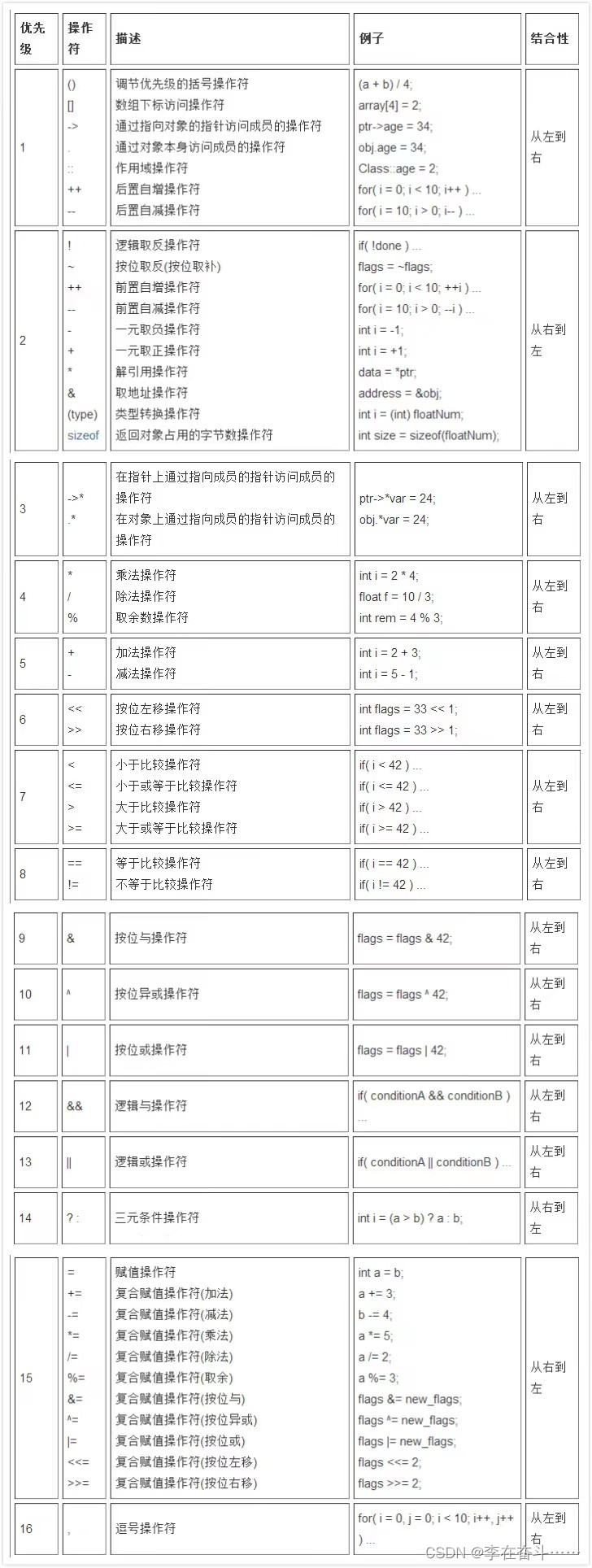文章目录
- (一)、什么是优先级?
- (二)、优先级表格都有什么?
- (三)、经典优先级举列.
- 1.1 前置++和后置++是什么?
- 1.2前置++后置++在判断语句中.
- 1.3前置++后置++在数据类型中.
- 1.4前置++后置++在输出语句中.
- 1.5前置++和前置++同在赋值语句中
- 1.6后置++和后置++同在赋值语句中
- 1.7后置++和后置++同在赋值语句中
- 前置++和后置++,单个赋值
- (四)总结.
(一)、什么是优先级?
优先级是指计算机分时操作系统在处理多个作业程序的时候,决定各个作业程序接收系统调用的先后。优先级越高、先调用。
(二)、优先级表格都有什么?
(三)、经典优先级举列.
本次我们以前置++和后置++进行详细讲说:
1.1 前置++和后置++是什么?
前置++:是先自增,然后再进行表达式.
后置++:是先进性表达式,再进行自增.
1.2前置++后置++在判断语句中.
后置++在判断语句中:在if语句中a++的值仍然为5,因为先进行表达式里面的判断语句得出来不满足,所以进入else语句,此时a=6,又+1所以结果为7.
在这里插入代码片#include <iostream>#include using namespace std;int main(){int a = 5;if (a++ > 5)cout << a << endl;else{cout << a+1;}}![图片[1] - 8.【C/C++优先级详解】 - MaxSSL](https://www.maxssl.com/uploads/?url=https://img-blog.csdnimg.cn/5f50b8e793c34679926fc1cab71f6e6b.png)
前置++在判断语句中: 先进性自增,然后再判断的出来if为真输出a
在这里插入代码片#include <iostream>#include using namespace std;int main(){int a = 5;if (++a > 5)cout << a << endl;else{cout << a+1;}}![图片[2] - 8.【C/C++优先级详解】 - MaxSSL](https://www.maxssl.com/uploads/?url=https://img-blog.csdnimg.cn/f3b7969fe2c74daa9f16b7b210249891.png)
1.3前置++后置++在数据类型中.
后置++在数据类型中:直接运行.
#include #include using namespace std;int main(){int a = 5;a++;cout << a << endl;}![图片[3] - 8.【C/C++优先级详解】 - MaxSSL](https://www.maxssl.com/uploads/?url=https://img-blog.csdnimg.cn/38d809b3bdbf4cc58f934f4edf6a1a31.png)
前置++在数据类型中:依然直接输出.
#include #include using namespace std;int main(){int a = 5;++a;cout << a << endl;}![图片[4] - 8.【C/C++优先级详解】 - MaxSSL](https://www.maxssl.com/uploads/?url=https://img-blog.csdnimg.cn/2f79479eedf547fc8bcc777929467c8d.png)
1.4前置++后置++在输出语句中.
后置++在输出语句中:因为a默认优先级为+,+的优先级小于++,所以我们先运行后面的后置++,又因为后置++先进性表达式,所以第二个a仍然为5,其余的为6.
#include #include using namespace std;int main(){int a = 5;cout << a << " " << a++ << endl;cout << a << endl;}![图片[5] - 8.【C/C++优先级详解】 - MaxSSL](https://www.maxssl.com/uploads/?url=https://img-blog.csdnimg.cn/9803f2aae7f24c7a9b4b9d5f02214b63.png)
输出语句中的前置++: 因为先进性前置++,所以结果都为6
#include #include using namespace std;int main(){int a = 5;cout << a << " " << ++a << endl;cout << a << endl;}![图片[6] - 8.【C/C++优先级详解】 - MaxSSL](https://www.maxssl.com/uploads/?url=https://img-blog.csdnimg.cn/365fb12b5e604367a175502119974939.png)
1.5前置++和前置++同在赋值语句中
()的优先级高于+、先执行两个小括号内的++,第一次++x的时候为5,放在储存区,第二次为6,所以两个结果都为6;
#include using namespace std;int main(){int a = 4,b;b =(++a)+(++a);cout << b << endl;}![图片[7] - 8.【C/C++优先级详解】 - MaxSSL](https://www.maxssl.com/uploads/?url=https://img-blog.csdnimg.cn/141056776e9541cab2a9bd165b22fdbe.png)
1.6后置++和后置++同在赋值语句中
先存值、后输出
#include using namespace std;int main(){int a = 4,b;b =(a++)+(a++);cout << b << endl;}![图片[8] - 8.【C/C++优先级详解】 - MaxSSL](https://www.maxssl.com/uploads/?url=https://img-blog.csdnimg.cn/830c38f50dde4e9f855401d8b8055b5d.png)
1.7后置++和后置++同在赋值语句中
后置++优先级高于前置++优先级,所以后置++先运行为4,前置++在5的基础上再+1为6.
#include using namespace std;int main(){int a = 4,b;b =(a++)+(++a);cout << b << endl;}![图片[9] - 8.【C/C++优先级详解】 - MaxSSL](https://www.maxssl.com/uploads/?url=https://img-blog.csdnimg.cn/56c9d019ce904f49a939efdc55bcd8ff.png)
前置++和后置++,单个赋值
后置++,先运算再++
#include #include using namespace std;int main(){int a=5,b;b = a++;cout << b << endl;}![图片[10] - 8.【C/C++优先级详解】 - MaxSSL](https://www.maxssl.com/uploads/?url=https://img-blog.csdnimg.cn/16020b058a574356a9639d9a98caf329.png)
(四)总结.
一定要看好优先级再进行数据判断!
© 版权声明
文章版权归作者所有,未经允许请勿转载。
THE END








